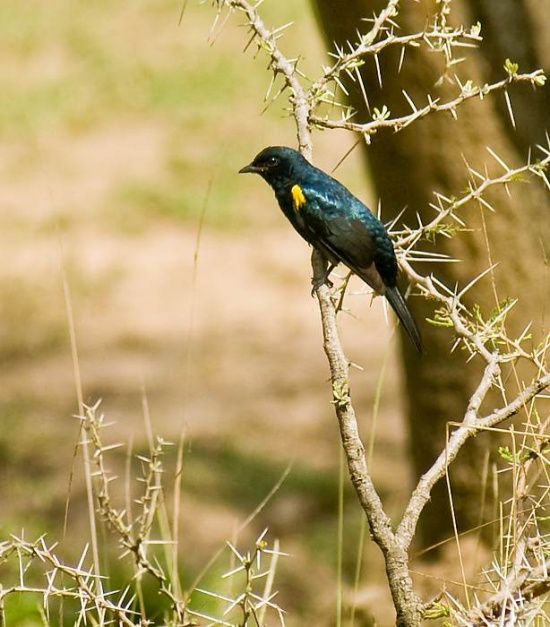Sbarnhardt (talk | contribs) (Added Black Cuckooshrike Female by volker sthamer to Identification section, Edited Aroberts species image to 550px and Added Copyright, Added square brackets to location in this image, Edited Black_Cuckoshrike_AlanManson_2011_12.jpg to 350px, Added Copyright to 2 Alan Manson and 1 volker sthamer preexisting photo captions, Removed square brackets from Weenen Game Reserve - No such article in Opus) |
Sbarnhardt (talk | contribs) (Clearer female image added, Alan Manson image removed) |
||
| Line 26: | Line 26: | ||
Woodlands and forest margins. | Woodlands and forest margins. | ||
==Behaviour== | ==Behaviour== | ||
| − | |||
Generally solitary or in pairs. | Generally solitary or in pairs. | ||
====Diet==== | ====Diet==== | ||
Revision as of 17:51, 30 December 2020
- Campephaga flava
Identification
Length 19-22 cm (7½-8¾ in)
Mass 32 g
Adult male
- Black overall plumage, bill, eyes and legs
- Bright orange gape
- Rounded tail
Some males have a yellow patch on the carpal joint.
Adult female
- Upper parts olive, finely barred black
- Tail brown and yellow
- Wings with yellow and blackish markings
- White under parts, finely scalloped black
Distribution
Africa: Woodland regions south of the Equator, extending northwards in eastern Africa to southern Somalia, southern Kenya, Uganda and southern Sudan.
Taxonomy
This is a monotypic species[1].
It has in the past been considered conspecific with Petit's Cuckoo-shrike.
Habitat
Woodlands and forest margins.
Behaviour
Generally solitary or in pairs.
Diet
Usually quiet and inconspicuous as they glean mainly insects from leaves, twigs and bark. Also occasionally eats fruit.
Breeding
Monogamous and territorial. The nest is a shallow cup built using moss, lichen and spider web. One to three eggs are laid September to February (in southern Africa).
Movements
Either resident or local migrant.
Vocalisation
Call: A high-pitched trill.
References
- Clements, JF. 2008. The Clements Checklist of Birds of the World. 6th ed., with updates to December 2008. Ithaca: Cornell Univ. Press. ISBN 978-0801445019.
- Hockey, PAR, WRJ Dean, and PG Ryan, eds. 2005. Roberts' Birds of Southern Africa. 7th ed. Cape Town: John Voelcker Bird Book Fund. ISBN 978-0620340533
- Lepage D. 2008. Avibase. Search for "Campephaga flava" downloaded March 2008.
- Sinclair, I and P Ryan. 2003. Birds of Africa South of the Sahara. Princeton: Princeton Univ. Press. ISBN 978-0691118154
- Handbook of the Birds of the World Alive (retrieved December 2016)
Recommended Citation
- BirdForum Opus contributors. (2024) Black Cuckooshrike. In: BirdForum, the forum for wild birds and birding. Retrieved 16 May 2024 from https://www.birdforum.net/opus/Black_Cuckooshrike







